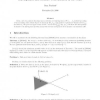Free Online Productivity Tools
i2Speak
i2Symbol
i2OCR
iTex2Img
iWeb2Print
iWeb2Shot
i2Type
iPdf2Split
iPdf2Merge
i2Bopomofo
i2Arabic
i2Style
i2Image
i2PDF
iLatex2Rtf
Sci2ools
COMPGEOM
2009
ACM
2009
ACM
Halving lines and measure concentration in the plane
Given a set of n points in the plane and a collection of k halving lines of P ℓ1, . . . , ℓk indexed according to the increasing order of their slopes, we denote by d(ℓj, ℓj+1) the number of points in P that lie above ℓj+1 and below ℓj. We prove an upper bound of 3nk1/3 for the sum Pk−1 j=1 d(ℓj, ℓj+1). We show how this problem is related to the halving lines problem and provide several consequences about measure concentration in R2 .
| Added | 28 May 2010 |
| Updated | 28 May 2010 |
| Type | Conference |
| Year | 2009 |
| Where | COMPGEOM |
| Authors | Rom Pinchasi |
Comments (0)

